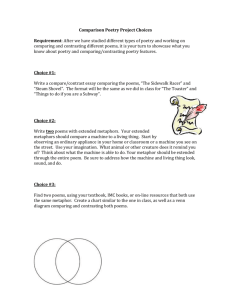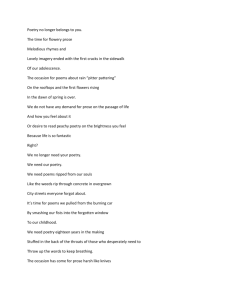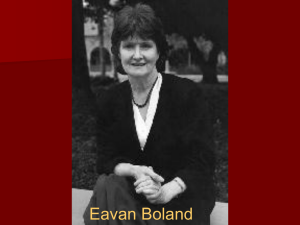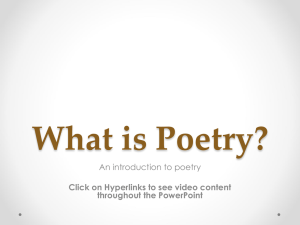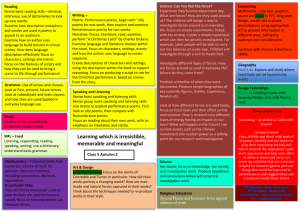Chapter 3: The Changing World of Children`s Books
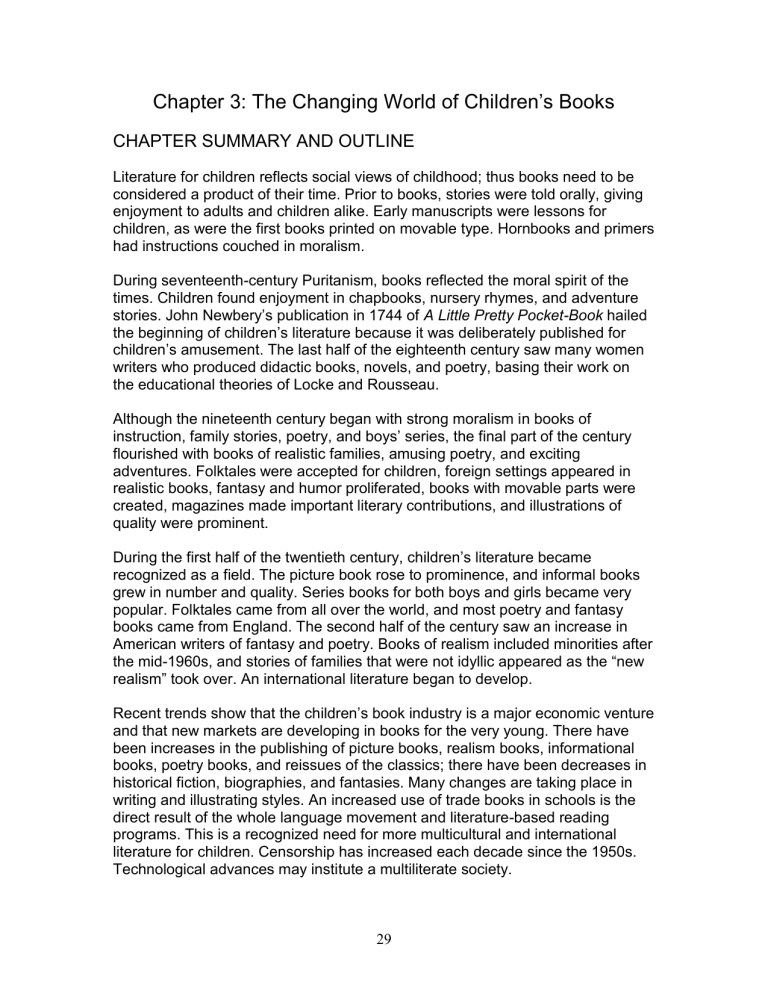
Chapter 3: The Changing World of Children’s Books
CHAPTER SUMMARY AND OUTLINE
Literature for children reflects social views of childhood; thus books need to be considered a product of their time. Prior to books, stories were told orally, giving enjoyment to adults and children alike. Early manuscripts were lessons for children, as were the first books printed on movable type. Hornbooks and primers had instructions couched in moralism.
During seventeenth-century Puritanism, books reflected the moral spirit of the times. Children found enjoyment in chapbooks, nursery rhymes, and adventure stories. John Newbery’s publication in 1744 of A Little Pretty Pocket-Book hailed the beginning of children’s literature because it was deliberately published for children
’s amusement. The last half of the eighteenth century saw many women writers who produced didactic books, novels, and poetry, basing their work on the educational theories of Locke and Rousseau.
Although the nineteenth century began with strong moralism in books of instruction, family stories, poetry, and boys’ series, the final part of the century flourished with books of realistic families, amusing poetry, and exciting adventures. Folktales were accepted for children, foreign settings appeared in realistic books, fantasy and humor proliferated, books with movable parts were created, magazines made important literary contributions, and illustrations of quality were prominent.
During the first half of the twentieth century, children’s literature became recognized as a field. The picture book rose to prominence, and informal books grew in number and quality. Series books for both boys and girls became very popular. Folktales came from all over the world, and most poetry and fantasy books came from England. The second half of the century saw an increase in
American writers of fantasy and poetry. Books of realism included minorities after the mid1960s, and stories of families that were not idyllic appeared as the “new realism” took over. An international literature began to develop.
Recent trends show that the children’s book industry is a major economic venture and that new markets are developing in books for the very young. There have been increases in the publishing of picture books, realism books, informational books, poetry books, and reissues of the classics; there have been decreases in historical fiction, biographies, and fantasies. Many changes are taking place in writing and illustrating styles. An increased use of trade books in schools is the direct result of the whole language movement and literature-based reading programs. This is a recognized need for more multicultural and international literature for children. Censorship has increased each decade since the 1950s.
Technological advances may institute a multiliterate society.
29
I. EARLY BEGINNINGS: THE MIDDLE AGES
A. The Oral Tradition
B. The Earliest Manuscripts
C. Caxton Begins English Printing
D. Hornbooks, ABCs, and Primers
E. Lasting Contributions of the Period
II. CHILDREN’S BOOKS: THE SEVENTEENTH AND EIGHTEENTH
CENTURIES
A. The “Goodly Godly” Books of the Puritans
B. Chapbooks: Forerunners of Comics
C. Fairy Tales and Adventure
D. Nursery Rhymes or Mother Goose
E. Newbery Publishes for Children
F. Didactic Tales
G. Poetry and Pictures
III. CH ILDREN’S LITERATURE: THE NINETEENTH CENTURY
A. Books of Instruction and Information
B. Folktale Collections
C. Family Stories
D. Tales of Adventure
E. Animal Stories
F. The Rise of Fantasy and Humor
G. Poetry
H. Magazines
I. Illustrators of the Nineteenth Century
IV. CHILDREN’S LITERATURE: THE TWENTIETH CENTURY
A. Recognition of Children’s Literature
B. The Rise of the Picture Storybook
C. The Growth of Nonfiction Books
D. The Proliferation of Series Books
E. Folktales of the World
F. Fantasy
G. Poetry
H. Realistic Fiction
I. An International Literature for Children
V. RECENT TRENDS IN CHILDREN’S BOOKS
A. Children’s Books: Big Business
B. New Books for New Markets
C. Shifts in Publishing Emphases
D. Changes in Writing and Illustration
E. Increased Use in Schools
F. Increased Censorship
G. The Multicultural World of Children’s Books
H. The Development of a Multiliterate Society
30
ASSISTING STUDENT LEARNING
INTRODUCTION
Note the chronological format of the chapter in the informal outline at the chapter beginning. As you read the chapter, try to organize the information into time periods.
Observe the principle that literature for children reflects society’s attitude toward children. Find evidence that supports this belief
EARLY BEGINNINGS
Find the purpose of storytelling throughout history.
Determine the purpose and form of early lesson books. Note some examples.
Determine the contribution William Caxton made to children’s books.
Be able to differentiate among hornbooks, ABCs, and primers.
Learn why Orbis Pictus is a landmark among children’s books.
SEVENTEENTH AND EIGHTEENTH CENTURIES
Show the effect Puritanism had on children’s books; do so by noting examples from this period.
Explain what chapbooks were and why they were popular.
Find one theory regarding the origin of the Mother Goose rhymes.
Find the major French connection in early fairy tales.
John Newbery’s publication of
A Little Pretty Pocket-Book is generally accepted as the beginning of children’s literature. Find out why this is true.
Determine the purpose of the didactic writers. When were they most prolific? What were some examples of their writings?
Characterize the poetry of the eighteenth century.
NINETEENTH CENTURY
Compare and contrast the purpose of writing for children in the nineteenth century with that of the eighteenth century.
What were the contributions of Noah Webster and William H. McGuffey to children’s literature?
Note some of the leading collectors of folktales in the nineteenth century.
Describe the family stories of the nineteenth century and give some examples.
Explain the term Robinsonades.
What was the status of boys’ stories in the nineteenth century?
What were the trendsetting animal stories?
Be able to recall some of the fantasies and humorous books of the second half of the nineteenth century.
Find out how the nature of poetry changed in the nineteenth century.
31
Magazines were very important in the last half of the nineteenth century. Describe what literary features they offered.
Identify the three best-known illustrators of the nineteenth century and their contributions.
Summarize children’s literature activity in the nineteenth century.
TWENTIETH CENTURY
Name at least three peripheral events that occurred in the twentieth century that were indicative of the fact that children ’s literature had been established as a field.
Skim the section on pictures. Look for information on illustrators whose names are familiar to you.
Look for four developments in informational books that represent the changes in these books.
Find one way that biographies changed in the twentieth century.
Give the critics’ reasons for their negativism about series books.
Determine who were some of the key folklorists of children’s collections in the twentieth century.
Read about two authors of fantasy whose works are familiar to you.
How did fantasy change in the latter quarter of the twentieth century?
Find two developments in children’s poetry in the twentieth century.
Find four changes in books of realism in the twentieth century.
What are two indicators of increased internationalism in children’s literature?
LANDMARKS CHART
Study the titles on the Landmarks Chart. State a reason why each book is designated as a landmark.
RECENT TRENDS
Give two reasons why there is a steady increase in the number of books published yearly.
Find several new kinds of books that are being published.
Describe several shifts in publishing emphases.
Find various kinds of experimentation in writing and illustration styles.
Determine the reason for increased use of trade books in schools.
What are some of the reasons for increased censorship?
Note the changes in multicultural and international publishing.
Determine the effect of a multiliterate society on children.
Key Vocabulary abridged version anthropomorphic big business conglomerate chapbook
32
classic classic narrative approach
Dickensian didactic dime novel end grain of a block of wood first-person telling frontispiece gilt paper global education
“here and now” hornbook independently owned publishing company jobber lecture approach literature-based reading programs manuscript moral platitudes moralistic movable type new realism oral tradition parodies preschool movement prig primer prototype pseudonym question-and-answer approach religious tracts rhymed couplets
Robinsonade secular reader spin-off books stereotype taboos in children’s literature to pirate a book
ORGANIZING THE TEXTUAL MATERIAL
COMBINING WITH OTHER CHAPTERS
If you are teaching on the quarter system and have a limited number of class meeting sessions, you might want to collapse the information in this chapter and use parts of it with other chapters. For example, the portions on genre studies — picture books, realism, fantasy, poetry, information books, folktales
—would be
33
used with those sections. The portion on early beginnings could be used with the first chapter as an introduction. The section on modern trends would make good final days’ discussion.
PLANNING FOR SPECIFIC AUDIENCES
The students whom you teach may influence how you will emphasize this chapter. Undergraduate elementary education majors may need more time for genre studies with their practical applications, so you might want to consider spending less time with this chapter when teaching them. Graduate students majoring in reading, language arts, or literature may benefit more from the philosophical grounding of this chapter than from the first chapter on values or from the genre chapters. You may want to give greater emphasis on history to these graduates. Students preparing for roles as school media specialists will benefit from a retrospective view of the field; study of history could give them the perspective they need. Generalists might also gain much from seeing the role of children’s literature in society and education, so you may want to give a disproportionate share of time to this chapter when teaching them.
INTRODUCING THE CHAPTER
Show the Weston Woods filmstrip The Tale of Peter Rabbit, by Beatrix Potter.
Tell about the origins of the story and discuss its place in American children’s literature.
Students might enjoy hearing you read aloud one of your favorite passages from a classic. One of the scenes of eating warm goat’s milk cheese and thick crusty bread from Johanna Spyri’s Heidi allows much imaging. The Christmas scene from Louisa May
Alcott’s
Little Women is also a pleasant memory for many students.
TEACHING WITH THE TEXTBOOK
1. EXHIBITING NINETEENTH- AND EARLY TWENTIETH-CENTURY
ILLUSTRATIONS
Give students a visual experience with children’s books of the past by creating an exhibit of books illustrated by outstanding nineteenth- and early twentieth-century artists. Use books illustrated by Walter Crane, Kate Greenaway, Randolph
Caldecott, Maurice Boutet de Monvel, Howard Pyle, Leslie Brooke, Beatrix
Potter, and Arthur Rackham. Many books by these illustrators have been reissued, so they are relatively easy to locate.
Students need guidance in looking at illustrations, so prepare them for the viewing by going over some of the books in detail. For example, you might discuss Arthur Rack ham’s The Sleeping Beauty.
Note his trees and ask students
34
what kind of emotions the trees evoke. Point out a focal point on a fully illustrated page. Ask what Rackham did to pull the viewer’s eye to that point. Discuss
Rackham’s choice of color; in what ways does the color effect the mood? Point out the use of half-light. Ask students to visualize what this would be like if the illustrator used a brighter light or a dimmer light. What effect has the half-light created?
After a brief demonstration and discussion, invite the students to view an exhibit of all the books. Follow this by having each student select one book (be sure to have more than enough to go around to ensure choice) and examine it carefully.
Have them follow the “Guidelines for Evaluating Picture Books” on page 223 of the textbook. Use the following questions, “Response to an Illustrated Book,” as a study guide.
Response to an Illustrated Book:
1. What medium did the illustrator use? Was it appropriate for the context of the book? Was it well executed?
2.
How effective was the illustrator’s use of the elements of art, such as perspective, shape, color, use of light and dark, line, space, etc.?
3. Was the style of art appropriate for the story?
4. What features of book design were significant in this book, i.e., book jacket, end pages, paper quality, borders, geography, etc.?
5. When this book is compared with others, how does it rate?
Reflecting on Methodology: Discuss with students your demonstration of a viewing of the illustrations. Point out that we push children to derive much information from picture images and we often tend to skim over teaching the visual literacy that goes with it. Ask students which questions prompted their thinking. Encourage them to find implications in this demonstration for their use in elementary classrooms.
Evaluation: Read the students’ comments on the response sheet to note their ability to abstract ideas from viewing illustrations.
2. COMPARING SERIES BOOKS: THEN AND NOW
School media specialists would be especially served by an in-depth study of series book. Decisions on the purchase of series books for school libraries have been controversial over the years.
Pre-class Assignment: Prior to the class, direct students to read a variety of series books. Try to include books from the following groups:
Nineteenth-Century British Authors
Captain Frederick Marryat
Robert Ballantyne
The Stratemeyer Syndicate
The Rover Boys series
The Bobbsey Twins series
35
George A. Henty
Nineteenth-Century American Authors
Horatio Alger
Oliver Optic
Harry Castleman
Tom Swift series
Nancy Drew series
The Hardy Boys series
1990s Series
Choose Your Own Adventure
Sweet Valley Twins
The Kids of Polk Street School
Goose Bumps
The Baby Sitters Club
Animorphs
Series of Unfortunate Events
Junie B. Jones
As part of the assignment, have students construct a framework that could guide the group evaluation. Most of them probably read series books as children and so have some notion of the pattern. Encourage them to consider the evaluation guides from Chapter 1, as well as the personal values from Chapter 2. Suggest a few guidelines such as, “When did you begin getting clues as to the ending?”
“What features of the character did you come to know well?”
In-class Activities: Ask for topics related to the series books that students anticipate will be good bases for comparison. Note these on the chalkboard.
Assign the students to small groups, making sure that various time periods are represented in each group. Distribute large (24 x 36-inch) sheets of paper and have them chart comparisons of the books.
Allow them to choose items for comparison from the chalkboard list or from ideas that come forth in their discussion. A sample chart might have headings as follows:
Title Character Predictability of Plot Exciting Adventures
When the groups are finished, share the findings and encourage students to note the patterns that emerge. Summarize by having students point out implications these findings have for the school media specialist.
Reflecting on Methodology: Discuss your preliminary work that prepared the students for the charting activity. What value did they find in the questions that you used to prompt the chart making? In what way, if any, did they limit the group discussion? Then lead students to analyze the chart-making activity with questions such as, What is the purpose of charting? What did you learn from the charting activity? How does it aid critical thinking? What is the most important part of the charting experience?
36
Evaluation: Listen to the discu ssions in the small groups, noting students’ ability to use literary criteria rather than personal reactions when evaluating books.
Move from group to group. Spend a set amount of time at each stop (2 minutes is an effective observation time) and keep track of the statements made during your observation. Notice literary criticism and personal statements. As time goes on, such evaluations will indicate how students are developing their ability to evaluate books. Include these observation commentaries in the student’s portfolio.
3. TRACKING THE EARLY READING OF OLDER PERSONS
Have students participate in a survey similar to the one described in the
Teaching Feature on page 96 of the textbook. Invite them to interview persons a generation older than themselves to learn what books they read when they were children. Make a large survey chart in the class to note the titles of the books.
Discuss which of the books are considered classics today.
Reflecting on Methodology: Have students think how they might use this same teaching idea in an elementary classroom. Discuss with them the parameters they would need to set for students to interview adults.
4. PARTICIPATING IN A CLASSICS READING FESTIVAL
Set up a reading schedule so students read a classic in full prior to coming to class. There is an excellent list on pages 99
–101 of the textbook that includes titles with original publication dates of many books still read as classics. It might be helpful for you to gather the books prior to the assignment so that books of similar length are offered for reading. Encourage students to choose a book that they know by title but have never read. During the reading, direct them to keep a journal of things that seem different by today’s standards. This might be style of writing, topics, descriptions, etc.
On an appointed day of the Reading Festival, have students share readings in class. Discuss the books and why these particular books lasted. Ask students to read brief passages that give the distinct flavor of the book. Raise questions that appeared in the journal of reading. Encourage those who read some of the books in their childhood to recall what they remember in plot and personal attitudes about the books.
5. READING POETRY FROM THE PAST
Many poems in today’s anthologies were originally composed in the eighteenth, nineteenth, and early twentieth centuries. Give students an opportunity to hear these poems and discuss their lasting quality. Plan a poetry reading session.
Collect poems from the eighteenth-, nineteenth-, and early twentieth-century poets discussed in the text. Many of their works are readily available in single-
37
poet collections, as well as in anthologies. The following anthologies offer most of the poets included in the textbook.
Blishen, Edward, compiler. The Oxford Book of Poetry for Children. Illustrated by Brian Wildsmith. Watts, 1963, reissued by P. Bedrick Books, 1984. This outstanding collection of primarily British poets includes many traditional poets going back to Shakespeare.
Elledge, Scott, ed. Wider Than the Sky: Poems to Grow Up With. Harper,
1990. Many traditional poets are included here, although they are primarily
British.
Ferris, Helen, selector. Favorite Poems Old and New. Illustrated by Leonard
Weisgard. Doubleday, 1957. This long-time standard contains poems by
Lewis Carroll, Christina Rossetti, William Allingham, John Greenleaf
Whittier, Robert Louis Stevenson, Eugene Field, James Whitcomb Riley,
Walter de la Mare, Eleanor Farjeon, A. A. Milne, Rachel Field, Dorothy
Aldis, Aileen Fisher, Edna St. Vincent Millay, Vachel Lindsay, Carl
Sandburg, Sara Teasdale, Emily Dickinson, Robert Frost, Countee Cullen,
Frances Frost, and Elizabeth Coatsworth.
Prelutsky, Jack, ed. The Random House Book of Poetry for Children.
Illustrated by Arnold Lobel. Random House, 1983. This collection contains
572 poems
—by all poets in the Ferris collection except Whittier and Cullen.
Numerous other poets are represented.
Give students an opportunity to practice reading the poems; unfamiliar stanzas need rehearsal. Then read with your students, presenting the poetry with as much sense of understanding as the group can manage. A chronological reading gives one perspective, but students may wish to organize the readings in other frameworks.
Follow the reading with a discussion prompted by questions such as: What kind of aesthetic reaction do you have following his listening experience? In what way did any of these poems have meaning for you? Can you find ways in which the poetry reflects the life of the poet? Why do these poems remain in print? What are the values, if any, of these poems today?
6. VISITING A COLLECTION OF RARE CHILDRE N’S BOOKS
There are rare children’s book collections large and small throughout the world.
Investigate institutional and private collections in your locale to find examples of the books discussed in the textbook. Librarians (both public and university), curators of history and art museums, members of friends of the library and antiquarian book groups, collectors, and booksellers often know local private collectors who may be willing to display, read excerpts, and discuss rare children’s books from their collections. A fine source of institutional collections is
Special Collections in Children’s Literature, edited by Dolores Blythe Jones (ALA,
38
1995). One listing in that book notes by state the various collections and details the types of books available.
Undergraduate students would benefit from the experience of planning a field trip. Give them responsibility for arranging transportation and other logistics as well as academic planning, such as pre-trip orientation about what will be seen, guided questions, etc. Be sure that arrangements are made for students to see and hear specific books that are discussed in the textbook. Involve students in all the social amenities that are necessary for such an excursion.
Reflecting on Methodology: Following the field trip, discuss its learning value with students. What did they gain from making travel plans? What more were they able to learn from seeing actual books and talking with a bona fide collector than from reading about the books second hand? In what ways was the learning experience worth the time and effort?
7. COMPARING INTERNATIONAL BOOKS PAST AND PRESENT
Prepare a book talk about books of the past that had international settings. Hans
Brinker: Or the Silver Skates by Mary Mapes Dodge is an example of a classic that stereotyped its particular country of origin. The Twins series were others that painted a picture of “foreign” that was quaint and unreal.
Follow these excerpts and commentaries with international books of today that show contemporary life, not people in native costumes. Books that would be appropriate are Vedat Dalakoy’s Sister Shako and Kolo the Goat: Memories of
My Childhood in Turkey
(Lothrop, 1994); Kazumi Yumoto’s
The Friends (Farrar,
Straus & Giroux, 1996) set in Japan; Somehow Tenderness Survives: Stories of
Southern Africa, selected by Hazel Rochman (Harper, 1990); and Beverly
Naidoo’s
The Other Side of Truth (HarperCollins, 2001). Read excerpts from these books and note the central themes of the books. Discuss the differences between these new international books and books of the past set in other lands.
Point out the realism in international books as indicative of the trend of the type of books being brought into the United States today.
8. NOTING BOOK TRENDS IN THE LAST QUARTER OF THE TWENTIETH
CENTURY
Bring in a collection of recent books that are trendsetters. Prepare a book talk that will show the distinctive features that set these books apart from those of earlier in the century. After you have shared comments about the books, arrange students in small groups and have them read excerpts from the books to note the features on which you have focused. Books that would be useful follow.
Briggs, Raymond. The Man. Knopf, 1995. A comic-book format for older children.
39
Colman, Penny. Girls: A History of Growing Up Female in America. Scholastic,
2000. A book that celebrates the contributions of females.
Danzinger, Paula. The United Tates of America. Scholastic, 2002. Includes the main character’s scrapbook as an insert.
Deem, James. 3NB’s of Julian Drew. Houghton Mifflin, 1994. Told as entries in code in a boy’s diary.
Jenkins, Steve. To the Top of the World: Climbing Mt. Everest. Houghton
Mifflin, 1999. A nonfiction book with stunning Illustrations.
Joyce, William. Rolie Polie Olie. HarperCollins, 1999. A computer-generated picture book.
Myers, Walter Dean. Monster. Illustrated by Christopher Myers. HarperCollins,
1999. A novel told in various visual and verbal formats.
Platt, Richard. Stephen Beisty’s Incredible Cross Sections: Castle. Illustrated by Stephen Beisty. DK, 1994. One of several large and highly detailed books.
Scieszka, Jon. Math Curse. Illustrated by Lane Smith. Viking, 1995. A picture storybook about mathematics.
Weisner, David. The Three Pigs. Clarion, 2001. The Caldecott winner of 2001.
The three pigs escape from the wolf —right out of the storybook.
BOOK CART BOOKS
The listing below is an extension of activity 8. Bring many of these books to class and have students read them for the trend-setting feature they employ.
Encourage them to reread the section of the textbook on “Recent Trends in
Children’s Books” for an overview of these types of books.
GROUNDBREAKERS AND NEW DIRECTIONS
Almond, David. Skellig. Delacorte, 1999
Almond, David. Secret Heart. Delacourte, 2002.
Avi. City of Light, City of Dark: A Comic Book Novel. Illustrated by Brian Floca.
Orchard 1993.
Begay, Shonto. Navajo: Visions and Voices across America. Scholastic, 1995.
Berry, James. Ajeemah and His Son. HarperCollins, 1992.
Buehner, Caralyn.
Fanny’s Dream.
Illustrated by Mark Buehner. Dial, 1996.
Bunting, Eve. Smoky Night. Illustrated by David Diaz. Harcourt Brace, 1994.
Colman, Penny. Corpses, Coffins, and Crypts: A History of Burial. Holt 1997.
Creech, Sharon. Love That Dog. HarperCollins, 2001.
Erdrich, Louise. The Birchbark House. Hyperion, 1999
Fanelli, Sara. Dear Diary. Candlewick, 2000.
Ferris, Jean. Once upon a Marigold. Harcourt, 2003.
Flake, Sharon.
The Skin I’m In.
Hyperion, 1998.
Fletcher, Ralph. I Am Wings: Poems about Love. Bradbury, 1994.
Gaflaz, Christophe, and Roberto Innocenti. Rose Blanche. Illustrated by
Roberto Innocenti. Creative Education, 1985.
40
Graham, Joan. Flicker Flash. Illustrated by Nancy Davis. Houghton Mifflin,
1999.
Harris, Robie H. It’s So Amazing: A Book about Eggs, Sperm, Birth, Babies, and Families. Illustrated by Michael Emberley. Candlewick, 1999.
Holmes, Barabara Ware. Following Fake Man. Illustrated by Sarah Hokanson.
Knopf, 2001.
Murphy, Jim. My Name Is America: The Journal of James Edmund Pease, A
Civil War Union Soldier. Scholastic, 1998.
Pfister, Marcus. The Rainbow Fish. North-South, 1992.
Rapp, Adam. The Buffalo Tree. Front Street, 1997.
Rosales, Melodye Benson. Leola and the Honeybears. Scholastic, 1999.
Rowling, J. K. Harry Potter and the Sorcerer’s Stone. Scholastic, 1998.
Sabuda, Robert. The Movable Mother Goose. Simon & Schuster, 1999.
Sis, Peter. Tibet: Through the Red Box. Farrar, Straus & Giroux 1998.
Testa, Maria. Becoming Joe DiMaggio. Illustrated by Scott Hunt. Candlewick,
2003.
Walter, Virginia. Making Up Megaboy. Illustrated by Katrina Roeckelein. DK,
1998.
Woodson, Jacqueline. I Hadn’t Meant to Tell You This. Delacorte, 1994.
EXTENDING LEARNING THROUGH AUDIO-VISUAL MATERIALS
Beatrix Potter: Artist, Storyteller, and Counrywoman. Weston Woods, 1992.
Film. 55 min. Color.
A superb film of the life of the renowned author of Peter Rabbit and other books, based on the biography written in the 1980s by Judy Taylor.
Mary Had a Little Lamb. Weston Woods, n.d. Filmstrip/cassette. 3 min.
Color.
Written by Sara Josepha Hale and illustrated by Tomie de Paola, this is an attractive bit of American children’s literature from the 1830s.
Mr. Shephard & Mr. Milne. Weston Woods, 1973. 16mm film/videocassette.
29 min. Color.
The collaboration between artist and writer for the Pooh books is described, as many places relevant to the stories are filmed. Christopher Robin Milne reads from his father’s stories and poems.
R. Caldecott: The Man behind the Medal. Weston Woods, n.d. Filmstrip, cassette. 15 min. Color.
Many of the artist’s drawings and picture books are featured in this historical biography.
41
Alice’s Adventures in Wonderland: Nonsense Poetry and Whimsy http://edsitement.neh.gov/view_lesson_plan.asp?id=354
This curriculum unit explores elements of wonder, distortion, fantasy, and whimsy in Lewis Carroll’s beloved classic Alice’s Adventures in Wonderland. After exploring their concepts about Wonderland, students listen to the opening chapters of The Nursery “Alice,” Carroll’s adaptation for younger readers, and view Sir John Tenniel’s illustrations from the original edition. Then students listen to Carroll’s whimsical poetry and write whimsical verses of their own.
Association of Library Services for Children: Great Web Sites for Kids http://www.ala.org/ALSCTemplate.cfm?Section=ALSC
This site includes a set of links titled “Extending the Classics.”
Weston Woods Studio: A Division of Scholastic http://teacher.scholastic.com/products/westonwoods/index.htm
Web site of Weston Woods Studio, maker of video adaptations that are faithful reflections of classic children’s books. Includes a timeline and preview portions from their fifty years of video-making.
WEB LINKS LISTED IN STUDENT STUDY GUIDE
Go to www.mhhe.com/huck8e, Chapter 3, to link to these sites. de Grummond Children’s Literature Collection
This site highlights one of North America’s leading research centers in the field of children’s literature. You’ll find images of original manuscripts and illustrations from notable authors and illustrators such as Ezra Jack Keats and Kate
Greenaway; an online catalog to search the collection’s fairy tales, folklore, and fable holdings; and links to other c hildren’s literature collections on the Web.
The Cotsen Children’s Library at Princeton University
This site is a delight to explore and includes a virtual exhibit of the highlights of the collection and information about the library’s outreach programs.
The Children’s Literature collection at The Lilly Library of Indiana University
This Web site includes an online exhibit of British Bookbinding and several interesting illustrations taken from the children’s books in this collection.
42
J. Paul Getty Museum
Here you can see a sampling of the J. Paul Getty Museum’s collection of illuminated manuscripts.
How a Book Is Made
Here you’ll find three different looks at how a book is made: through text and illustrations, author/illustrator Aliki explains ten basic stages, from taking an idea to working with a book designer to the child reading the finished book; with downloadable activity pages, pop-up book creator David Carter offers tips on how to make a pop-up book; Patricia McLaughlin and Barry Moser share how they collaborated on their book, What You Know First.
Social History of Children’s Literature
An article on the social history of children’s literature by Kay Vandergrift.
History of Children’s Books and Other Media
Part of the History and Childhood Education site, this page consists of a collection of links related to the history of children’s books.
Landmarks in the History of Children’s Literature
An article by Roger Blackwell Bailey, Ph.D.
43

